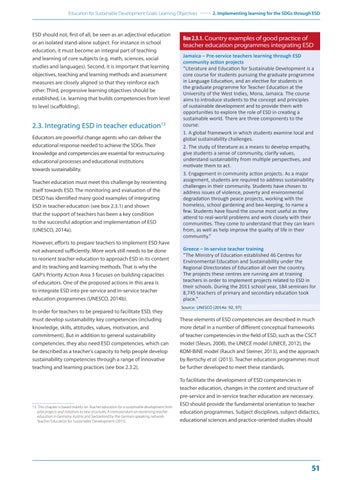Education for Sustainable Development Goals: Learning Objectives
ESD should not, first of all, be seen as an adjectival education or an isolated stand-alone subject. For instance in school education, it must become an integral part of teaching and learning of core subjects (e.g. math, sciences, social studies and languages). Second, it is important that learning objectives, teaching and learning methods and assessment measures are closely aligned so that they reinforce each other. Third, progressive learning objectives should be established, i.e. learning that builds competencies from level to level (scaffolding).
2.3. Integrating ESD in teacher education13 Educators are powerful change agents who can deliver the educational response needed to achieve the SDGs. Their knowledge and competencies are essential for restructuring educational processes and educational institutions towards sustainability. Teacher education must meet this challenge by reorienting itself towards ESD. The monitoring and evaluation of the DESD has identified many good examples of integrating ESD in teacher education (see box 2.3.1) and shown that the support of teachers has been a key condition to the successful adoption and implementation of ESD (UNESCO, 2014a). However, efforts to prepare teachers to implement ESD have not advanced sufficiently. More work still needs to be done to reorient teacher education to approach ESD in its content and its teaching and learning methods. That is why the GAP’s Priority Action Area 3 focuses on building capacities of educators. One of the proposed actions in this area is to integrate ESD into pre-service and in-service teacher education programmes (UNESCO, 2014b).
2. Implementing learning for the SDGs through ESD
Box 2.3.1. Country examples of good practice of teacher education programmes integrating ESD Jamaica – Pre-service teachers learning through ESD community action projects “Literature and Education for Sustainable Development is a core course for students pursuing the graduate programme in Language Education, and an elective for students in the graduate programme for Teacher Education at the University of the West Indies, Mona, Jamaica. The course aims to introduce students to the concept and principles of sustainable development and to provide them with opportunities to explore the role of ESD in creating a sustainable world. There are three components to the course: 1. A global framework in which students examine local and global sustainability challenges. 2. The study of literature as a means to develop empathy, give students a sense of community, clarify values, understand sustainability from multiple perspectives, and motivate them to act. 3. Engagement in community action projects. As a major assignment, students are required to address sustainability challenges in their community. Students have chosen to address issues of violence, poverty and environmental degradation through peace projects, working with the homeless, school gardening and bee-keeping, to name a few. Students have found the course most useful as they attend to real-world problems and work closely with their communities. They come to understand that they can learn from, as well as help improve the quality of life in their community.” Greece – In-service teacher training “The Ministry of Education established 46 Centres for Environmental Education and Sustainability under the Regional Directorates of Education all over the country. The projects these centres are running aim at training teachers in order to implement projects related to ESD in their schools. During the 2011 school year, 184 seminars for 8,745 teachers of primary and secondary education took place.” Source: UNESCO (2014a: 92, 97)
In order for teachers to be prepared to facilitate ESD, they must develop sustainability key competencies (including knowledge, skills, attitudes, values, motivation, and commitment). But in addition to general sustainability competencies, they also need ESD competencies, which can be described as a teacher’s capacity to help people develop sustainability competencies through a range of innovative teaching and learning practices (see box 2.3.2).
These elements of ESD competencies are described in much more detail in a number of different conceptual frameworks of teacher competencies in the field of ESD, such as the CSCT model (Sleurs, 2008), the UNECE model (UNECE, 2012), the KOM-BiNE model (Rauch and Steiner, 2013), and the approach by Bertschy et al. (2013). Teacher education programmes must be further developed to meet these standards.
13. This chapter is based mainly on Teacher education for a sustainable development from pilot projects and initiatives to new structures. A memorandum on reorienting teacher education in Germany, Austria and Switzerland by the German-speaking network Teacher Education for Sustainable Development (2015).
To facilitate the development of ESD competencies in teacher education, changes in the content and structure of pre-service and in-service teacher education are necessary. ESD should provide the fundamental orientation to teacher education programmes. Subject disciplines, subject didactics, educational sciences and practice-oriented studies should
51


